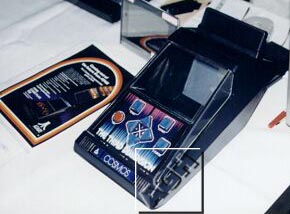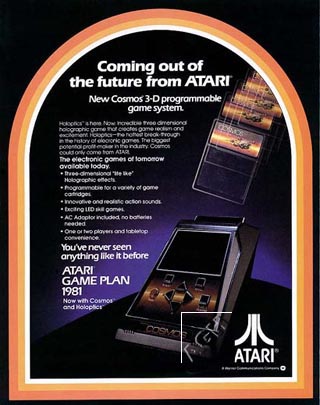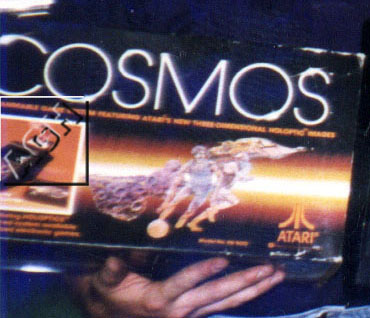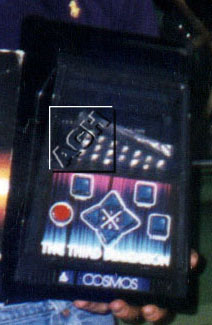ATARI COSMOS -

|
From 1978-1981, Atari spent considerable time developing Cosmos,
a handheld holography game system. Cosmos was a table top game system
that combined three-dimensional Holoptic images, sophisticated
(According to Atari, not us) LED game play and innovative sound effects.
The system was programmable and, initially, 8 game cartridges were to be
available. They were: Asteroids, Superman,
Football, Road Runner, Sea Battle,
Space Invaders and Outlaw. The eighth game
title is unknown.
Because one of the microprocessors was dedicated entirely to sound, Cosmos was to provide realistic sound effects which were light years beyond any handheld electronic game in its time. The other microprocessor accounted for Cosmos' LED game play. Cosmos operated by inserting the game cartridge into the slot provided which positioned the image in front of an array of LEDs. The player saw a green three-dimensional image superimposed over red game figures illumniated by the LED's> During game play, the red figures move about the illuminated screen under computer and player control. At certain moments of the game, the 3-D image would change to indicate an outcome or some new aspect of game play. There were two seperate holographic images on each game cartridge. In May, 1981, Atari announced that the machine was ready to be released but never stated an exact date when it would be available in stores. The console was to retail at $100 and eight game cartridges, among them the ever popular Asteroids and Space Invaders, were to be sold for $10 each. Advance reviews of the console complained that the holograms really didn't enhance the game play and were merely used as backdrops. Atari conceded that this was true but defended it by saying that since Cosmos was the first of its kind, such trivialities could be overlooked.

Cosmos was indeed an important breakthrough for Atari. For several years the company had been so committed to the development of holograms, that it bought out every hologram related patent it could find without any idea on what it was even going to do with them. By the end of 1979, engineers in Research & Development had learned how to mass produce holograms and Cosmos was the result of this. Since Atari was a videogame company, it was only natural that its first hologram product was a videogame. While Cosmos was being readied for release, its inventors were also exploring how to tie holograms into 3-D television and film.

Consumers anxiously awaited Cosmos but they waited in vain. By year's end Atari announced that it was listening to the critics' complaints and was redesigning the Cosmos holographic game system so that holograms did more than just provide a nice background to the action. It is possible that the slagging stand-alone (handheld and tabletop) market had much to do with Atari's withdrawl. Following that announcement, Cosmos, and the rest of Atari's holographic research, was never heard about again.
To date, only one Atari Cosmos has been located and shown. Atari Gaming Headquarters (that's us) purchased the only known unit and its box from an ex-Atari employee and revealed it for the first time at the World of Atari '98 show in Las Vegas this past August 21-23, 1998. Unfortunately, the unit is only an empty shell mock-up with no electronics. Here's hoping that a working Cosmos will be discovered some day.... Although a considerable amount of time, energy and resources went to waste as a result of Cosmos's failure, not all was lost, however. Lyle Rains, a game designer with Atari's coin-op division since 1973 through much of 1978, worked on a two player outer space dogfight game for Cosmos. The 3D screen for Rains' game displayed two moving spaceships and several planets and asteroids, which the players could destroy and had to avoid. Although the game was never produced, Rains was very fond of it and thought about it constantly. When Space Invaders caught on in the United States, Rains suddenly thought about what the game might be like if the asteroids moved. He mentioned this idea to an Atari programmer Ed Logg and within two weeks, Logg had a working prototype. The game was so much fun that Logg had to build a second prototype for his friends to play. The coin-op game developed by Rains and Logg eventually was released with the name "Asteroids," and the rest, as we all know, is history! ------------------------------------------------- Some of the above content came courtesy of the book "Phoenix: The Fall and Rise of Home Videogames" by Leonard Herman (Rolenta Press, 1994), pp. 53, 74-75.
For information on how to order this fine book, contact |

